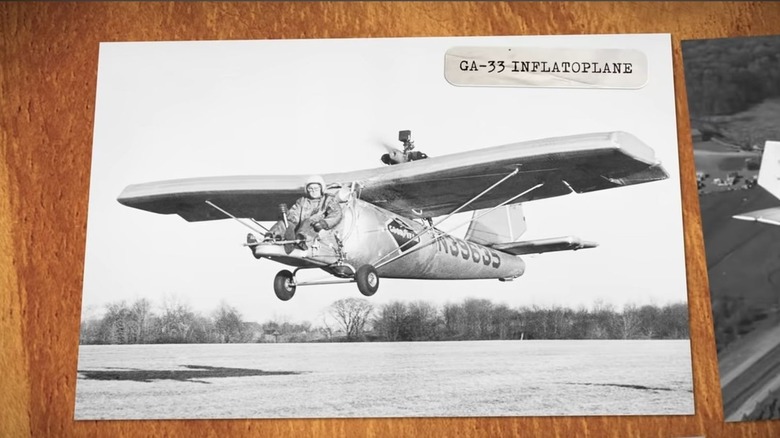The Bizarre Inflatable Plane Designed To Be Dropped Behind Enemy Lines
Frank Seiberling founded The Goodyear Tire & Rubber Company in August 1898, naming it after Charles Goodyear, the man who developed the rubber vulcanization process 59 years earlier, in 1839 (via Goodyear). The company built its first blimp in 1917 (via Goodyear), and in 1923, established the Goodyear Zeppelin Company to continue making them for both the private sector and U.S. Navy.
During World War II, the company changed its name to Goodyear Aircraft Corporation and went from just building blimps to making the FG-1D Corsair (via Ohio History Connection) and parts for the P-61 Black Widow (via The Smithsonian Institute). In 1963 the company changed the division name to Goodyear Aerospace Corporation and went on to help NASA design environmental controls for its Apollo spaceships, made tires for the lunar rovers and flotation devices for space capsules returning to Earth (via Ohio History Connection).
Having both the chops and experience to build various airships, the Navy contracted Goodyear in 1956 to build a tiny inflatable plane that could be used to rescue downed pilots from hostile territory. It kicked out the first prototype Inflatoplane (GA-33) in a mere 12 days.
It was a single-seater with a hand crank two-cycle 40 hp Nelson H-59 engine situated on top of the wings. Everything but the fuselage (standard blimp fabric) was built using a proprietary rubber material called AIRMAT that had the "highest strength-to-weight ratio" of any known material (via Stonehenge Air Museum).
Don't worry, it won't pop (hopefully)
It had a 22-foot wingspan and was 19 feet 7 inches long. The 20-gallon gas tank gave it a range of some 6.5 hours (roughly 390 miles) and a top speed of 60 mph. It could take off in just 250 feet but needed 575 feet if obstacles were in the way (like a tree). The climbing rate was 550 feet per minute, with a ceiling of roughly 10,000 feet (via The Smithsonian Institute).
Weighing only 240 pounds (via The Smithsonian Institute), the deflated plane could fit inside a 44 cubic foot container (via Stonehenge Air Museum) and get dropped from virtually anywhere. It could be inflated in less than five minutes (via The Smithsonian Institute), first using a hand pump. Only eight psi was needed, according to Plane & Pilot Magazine. And after, the engine would fill it up the rest of the way. Constant air compression from the motor kept the plane filled with air, even if it got hit by "several .30 caliber bullets" (via Stonehenge Air Museum).
A total of 12 Inflatoplanes were built across three months, but testing and analysis continued until 1972 (via The Smithsonian Institute). Four versions were made, each with different features, including a second seat, an enclosed cockpit, and improved range and top speed (via Plane & Pilot Magazine). Alas, the project was shut down in 1973, according to the Smithsonian, as the helicopter became the preferred method of rescue (via Stonehenge Air Museum).
